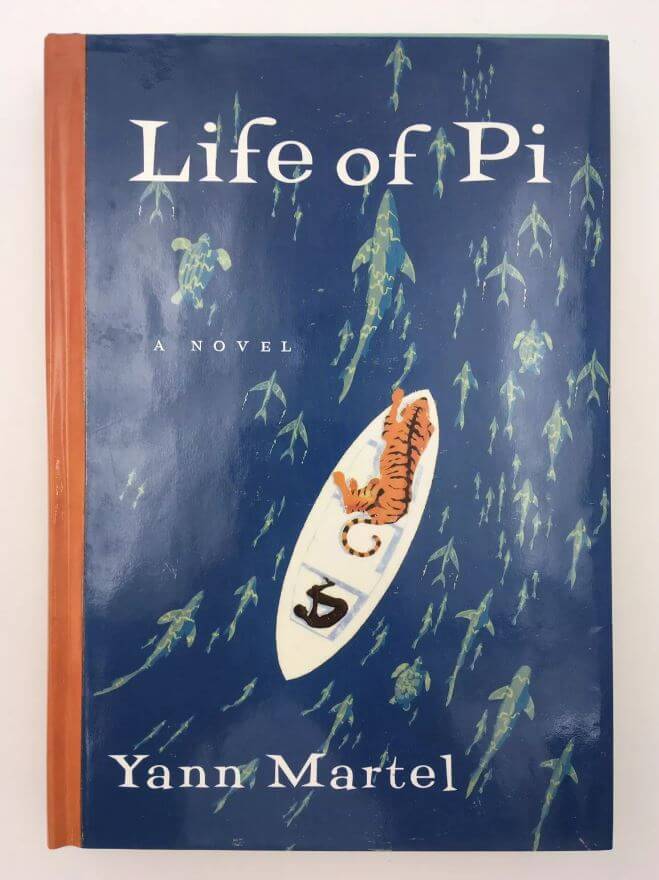Life of Pi, published in 2001 by Yann Martel, is a mesmerizing novel that blends adventure, philosophy, and spirituality into a narrative that is both thought-provoking and emotionally resonant. The novel, which won the Man Booker Prize in 2002, tells the extraordinary story of a young boy named Piscine Molitor Patel, known as “Pi,” who survives a shipwreck and is stranded on a lifeboat in the Pacific Ocean with a Bengal tiger named Richard Parker. Through Pi’s journey of survival, Life of Pi explores themes of faith, the will to survive, and the boundaries between reality and fiction.
Life of Pi has been widely acclaimed for its originality, depth, and narrative ingenuity. The novel’s blend of adventure, philosophy, and spiritual inquiry has resonated with readers across cultures and age groups, making it a modern classic.
Critics have praised Martel for his ability to weave complex themes into a compelling narrative, though some have noted that the book’s ambiguity and philosophical undertones may not appeal to all readers. Nonetheless, the novel’s imaginative premise and thought-provoking ending have made it a subject of discussion and analysis in literary circles and book clubs worldwide.
In 2012, Life of Pi was adapted into a visually stunning film directed by Ang Lee, which further popularized the story and introduced it to a broader audience.
Scores:
- Content Quality: 9/10
- Structural Logic: 8/10
- Language Expression: 9/10
- Readability: 9/10
- Information Accuracy: N/A (Fiction)
- Total Score: 8.75/10
Life of Pi by Yann Martel review
A Captivating Journey of Survival and Spiritual Discovery
I recently finished reading Life of Pi by Yann Martel, and it is a book that I won’t forget anytime soon. The novel follows the extraordinary story of a young boy named Pi Patel, who survives a shipwreck only to find himself stranded in the middle of the Pacific Ocean on a lifeboat with a Bengal tiger named Richard Parker. This unique premise is just the beginning of a gripping tale of survival, faith, and the human spirit.
What I loved most about Life of Pi is its profound exploration of spirituality and the search for meaning in the face of seemingly insurmountable odds. Martel’s writing is both lyrical and thought-provoking, seamlessly blending adventure with philosophical musings on religion, faith, and the nature of storytelling itself. Pi’s journey is not just a physical battle for survival but also a spiritual odyssey that challenges readers to consider their own beliefs about God, truth, and the power of the human will.
The relationship between Pi and Richard Parker is at the heart of the novel, and it’s beautifully developed. The dynamic between boy and tiger is tense and compelling, full of moments of fear, awe, and unexpected tenderness. Their interactions create a powerful metaphor for the coexistence of fear and faith, highlighting the ways in which we confront our inner beasts in order to survive.
Martel also does a fantastic job of immersing the reader in the vast, often terrifying, landscape of the ocean. His descriptions of the sea, the weather, and the various creatures Pi encounters are vivid and evocative, making you feel as though you’re right there on the lifeboat with them. The book’s ending adds another layer of complexity, leaving readers to ponder the nature of truth and storytelling.
In the vast ocean of literature, “Life of Pi” by Yann Martel stands as a buoyant testament to the resilience of the human spirit and the power of storytelling. It’s a tale that bends the boundaries between reality and fiction, faith and science, and survival and despair.
At its core, the novel follows the journey of Piscine Molitor Patel—nicknamed Pi—an Indian boy who finds himself stranded on a lifeboat in the Pacific Ocean after a shipwreck. But this isn’t just your typical survival story. The lifeboat is not empty; it’s shared with a Bengal tiger named Richard Parker. The unlikely companionship between Pi and this majestic yet terrifying creature forms the backbone of Martel’s narrative, weaving a tapestry of tension, fear, and ultimately, understanding.
Martel’s prose dances like sunlight on water—sometimes shimmering with beauty, other times dark and murky with existential questions. The first half of the book is rich with Pi’s upbringing in Pondicherry, where he explores different religions and philosophies, embracing a deep spirituality that will guide him during his harrowing ordeal. This exploration of faith is not merely a backdrop; it becomes a lifeline, a way for Pi to make sense of his suffering and isolation.
The second half of the book plunges into the depths of survival. Stripped of the comforts of civilization, Pi must confront hunger, despair, and the primal instinct to survive. The relationship between him and Richard Parker is a fascinating study in fear and companionship. It raises questions about the nature of existence and what it means to coexist with the wild.
Martel’s ability to blur the lines between reality and storytelling is masterful. He challenges readers to ponder the nature of truth itself. As Pi recounts his incredible story, he presents two versions—one involving animals and one that is far more grim and realistic. The choice left to the reader—to believe in the fantastical or the mundane—is a profound commentary on the human experience. Which story do you prefer? Which one holds more truth?
Emotionally charged and philosophically rich, “Life of Pi” is not just a tale of survival; it’s an exploration of faith, identity, and the narratives we choose to inhabit. Martel’s innovative storytelling invites readers to embark on their own journey of introspection.
In conclusion, “Life of Pi” is a beautifully crafted novel that resonates long after the last page is turned. It’s a reminder of the strength found in vulnerability and the stories that shape our lives. Whether you see it as a spiritual odyssey or an adventurous survival tale, one thing is certain: it’s a book that will leave you pondering the depths of belief, the essence of life, and the stories we tell ourselves. So, if you haven’t yet ventured into Pi’s world, grab a copy and prepare to set sail on a journey that’s both extraordinary and profoundly human.
Similar Books
- Life of Pi by Yann Martel

- “The Alchemist” by Paulo Coelho: A philosophical novel about a young shepherd’s journey of self-discovery, filled with spiritual insights and allegorical meanings.

- “The Old Man and the Sea” by Ernest Hemingway: A classic tale of struggle and endurance, focusing on an old fisherman’s battle with a giant marlin in the Gulf Stream.

- “The Road” by Cormac McCarthy: A harrowing story of a father and son’s survival journey in a post-apocalyptic world, exploring themes of hope, despair, and the human spirit.

If you enjoyed “Life of Pi,” you might also like:
Plot Summary:
The story begins with Pi Patel’s upbringing in Pondicherry, India, where his father runs a zoo. Pi is a curious and spiritually inclined boy who practices Hinduism, Christianity, and Islam simultaneously, reflecting his deep interest in understanding God from multiple perspectives.
The novel takes a dramatic turn when Pi’s family decides to emigrate to Canada, bringing several zoo animals with them aboard a cargo ship. Tragically, the ship sinks during a storm, leaving Pi as the sole human survivor on a lifeboat. To his astonishment, he discovers that he is not alone—he is accompanied by a zebra, a hyena, an orangutan, and, most dauntingly, a Bengal tiger named Richard Parker.
Over the course of 227 days at sea, Pi must use his knowledge of animal behavior, his wits, and his faith to survive. He forms an uneasy truce with Richard Parker, managing to coexist with the tiger in the confined space of the lifeboat. The novel’s narrative is interspersed with Pi’s reflections on religion, survival, and the nature of storytelling, culminating in a surprising and ambiguous ending that challenges readers to question the nature of truth and belief.
Book Characters:
Yann Martel creates memorable characters that are rich in depth and complexity:
-
Pi Patel
is a remarkable protagonist, whose introspective nature and spiritual curiosity make him a compelling guide through the novel’s philosophical terrain. Pi’s ingenuity, resilience, and deep faith are central to his character, making his journey one of both physical and spiritual survival.
-
Richard Parker
, the Bengal tiger, serves as both a literal threat to Pi’s life and a symbolic representation of the untamed and instinctual forces that Pi must grapple with. The tiger’s presence on the lifeboat forces Pi to confront his fears and instincts, ultimately serving as a catalyst for his growth and survival.
-
Pi’s parents and brother Ravi
, though less prominent in the narrative, are crucial to understanding Pi’s background and motivations. Their influence shapes his worldview and underscores the personal losses he suffers in the shipwreck.
Martel’s characters are crafted with a blend of realism and allegory, providing readers with both a literal and metaphorical lens through which to interpret the story. The relationship between Pi and Richard Parker, in particular, is a masterful exploration of coexistence, fear, and companionship under extreme circumstances.
Themes
-
Faith and Spirituality
: “Life of Pi” is fundamentally a novel about faith—its complexities, contradictions, and sustaining power. Pi’s devotion to multiple religions reflects his deep curiosity about the nature of God and spirituality. Throughout his ordeal, Pi’s faith is both challenged and reinforced, showcasing how belief can provide comfort and meaning in the face of incomprehensible hardship.
-
Survival and the Human Spirit
: The novel is also a gripping survival story that examines the lengths to which humans will go to stay alive. Pi’s ingenuity and determination highlight the resilience of the human spirit. His relationship with Richard Parker, while fraught with danger, becomes a critical aspect of his survival, symbolizing both the animalistic instincts and the higher consciousness within us all.
-
The Power of Storytelling
: Martel’s novel is a testament to the power of storytelling as a means of making sense of the world. The narrative itself is presented as a story that could be real or allegorical, leaving readers to ponder the nature of truth and fiction. This theme is particularly poignant in the novel’s ambiguous ending, which asks readers to choose between two versions of Pi’s tale, raising questions about what we choose to believe and why.
-
The Coexistence of Contradictions
: Pi’s life is marked by contradictions—from his devotion to multiple religions to his coexistence with a deadly tiger on a lifeboat. The novel embraces these contradictions, suggesting that life itself is a series of paradoxes, and that understanding and acceptance often lie in the ability to hold conflicting truths simultaneously.
Writing Style
Yann Martel’s writing in “Life of Pi” is lyrical and evocative, blending poetic descriptions with philosophical musings. The novel’s prose is rich and immersive, painting vivid images of the Pacific Ocean and the various trials Pi endures. Martel’s use of first-person narration allows readers to experience Pi’s thoughts and emotions intimately, adding depth and immediacy to his story. The narrative is structured in three parts: Pi’s life before the shipwreck, his time on the lifeboat, and his life after rescue, each serving to build a fuller picture of his character and his journey.
Strengths
“Life of Pi” is a remarkable novel for its originality and depth. Martel successfully combines a thrilling survival story with profound philosophical questions, creating a narrative that is both entertaining and thought-provoking. The character of Pi is endearing and complex, and his relationship with Richard Parker adds a unique layer of tension and intrigue to the story. The novel’s exploration of faith, survival, and the nature of truth resonates on multiple levels, making it a rich text for analysis and discussion.
Critique
Some readers might find the novel’s pacing slow, especially in the beginning, where Martel takes time to establish Pi’s background and religious beliefs. Additionally, the novel’s philosophical and allegorical elements may not appeal to those looking for a straightforward adventure story. The ambiguous ending, while adding depth, could also be frustrating for readers who prefer clear resolutions.
Conclusion:
Life of Pi by Yann Martel is a beautifully crafted novel that challenges readers to explore the boundaries between faith, survival, and storytelling. Through its captivating narrative and richly drawn characters, the book invites deep reflection on the nature of belief, the resilience of the human spirit, and the power of stories to shape our understanding of the world. Whether you are drawn to its adventure, its philosophical depth, or its spiritual inquiry, Life of Pi offers a reading experience that is both intellectually engaging and emotionally moving, making it a must-read for anyone interested in literature that transcends genres and provokes thought.



